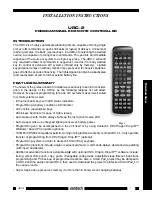
flowSCREW 4w
packages
Copyright Vincotech
Handling Instruction
03
rem. sect. 5.2; mod. at sect. 5.1 29.09.2014
Gyimóthy Zs.
Gyetvai T.
FSWB-M-*-HI
Page
6 /
18
02
remove section 6.2
14.05.2014
Gyimóthy Zs.
Gyetvai T.
01
20.02.2014
Gyimóthy Zs.
Gyetvai T.
Ver.
Alteration
Date
Des. / Mod.
Appr.
2.1 PCB assembly with press-fit technology
The driver PCB may be screwed to the module after press-fitting. This is recommended
if there are cable connectors or plugs on the PCB.
The driver PCB may be no less than 1.6 mm thick.
The PCB is to be covered with solder mask on both sides.
The plated through-hole specification for press-fit pins is as follows:
o
Hole size prior to plating: 1.6 +/-0.025 mm
o
Thickness of the PTH wall > 25 μm Cu
o
The plated hole's final size: 1.45 +0.09 / -0.06 mm
o
Minimum Cu width of the annular ring > 0.1 mm
Plating material:
o
Sn: 0.5 µm – 10 µm
The PCB may be disassembled and reused twice.
o
Au: 0.05
– 0.2 μm over 2.5 – 5 μm Ni.
The PCB may be used once only!
(Any other kind of plating needs to be tested.)
Minimum distance between the edge of the PCB and center of the pinhole: 4 mm
Minimum distance between the center of the pinhole and the component on the PCB: 4
mm
2.2 PCB assembly with soldered Press-fit pin modules
T
he recommended PCB hole diameter is 1.85 ± 0.1 mm for Press-fit pins that are to be
soldered rather than press-fitted.
Note
that the annular ring has to be designed to the
standards for through-hole components.
For more on this, please read section 11,
3 Base plate surface specification
The mounted module's thermal properties will not be affected by surface imperfections if the
following rules are observed:
The entire nickel plated surface may be polished
(see Figure 5)
provided that the
copper is not exposed.
A module is deemed to be scratched when the base plate copper is visible. The
scratch's depth and width may not
exceed 200 μm and 800 μm. The length is
undefined, but the total area of scratches may not exceed 5% of the overall substrate
surface.
The diameter and depth of etching holes must be less than
1000 μm and 200 μm as
shown in
Figure 4
.
Discolorations and fingerprints on the base plate are merely surface imperfections and do not
adversely affect the module's functions (see
Figures 6
and
7)
.




































